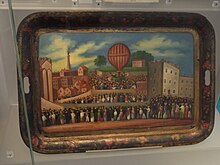Our website is made possible by displaying online advertisements to our visitors.
Please consider supporting us by disabling your ad blocker.
Japanning

Japanning is a type of finish that originated as a European imitation of East Asian lacquerwork. It was first used on furniture, but was later much used on small items in metal. The word originated in the 17th century. American work, except in the carriage and early automobile industries, is more often called toleware.[1]
It is distinct from true East Asian lacquer, which is made by coating objects with a preparation based on the dried sap of the Toxicodendron vernicifluum tree, which was not available in Europe.
Japanning is most often a heavy black lacquer, almost like enamel paint. Black is common, and japanning is often synonymous with black japanning. The European technique uses varnishes that have a resin base, similar to shellac, applied in heat-dried layers which are then polished, to give a smooth glossy finish. It can also come in reds, greens and blues.
Originating in India, China and Japan as a decorative coating for pottery, authentic East Asian lacquered ware made its way into Europe by the 17th century. In the late 17th century, high European demand (along with rumors that East Asian manufacturers reserved their higher-quality work for their domestic markets) led to the production of imitation pieces starting in Italy. Its traditional form used gold designs and pictorials to contrast with the black base colour.

- ^ "A Study of the Methods and Operations of Japanning Practice". Automotive Industries (42): 669. 11 Mar 1920.
Previous Page Next Page


